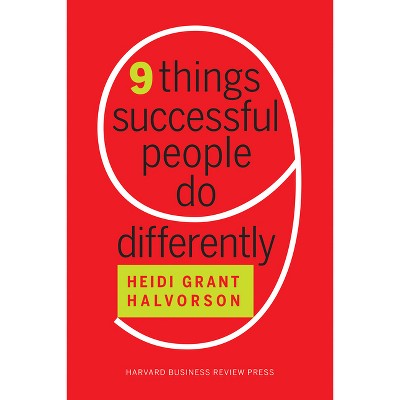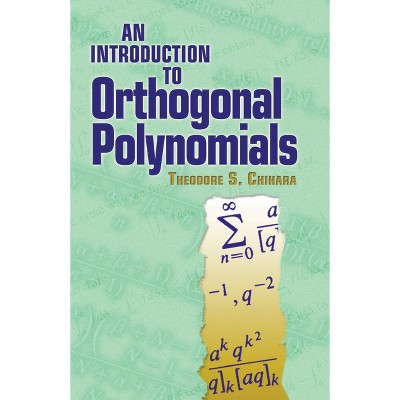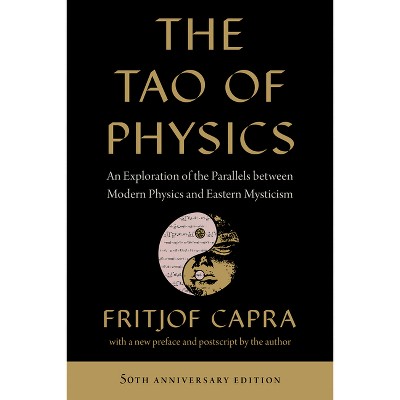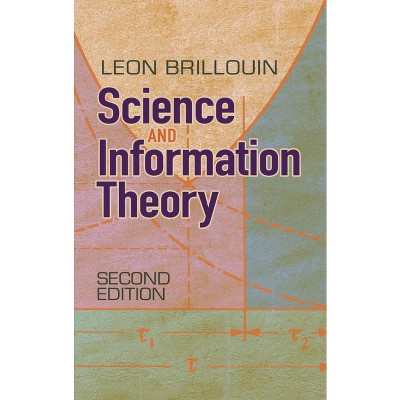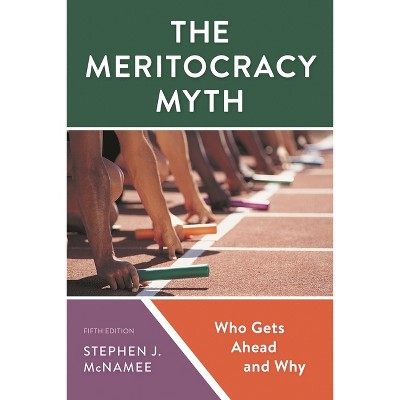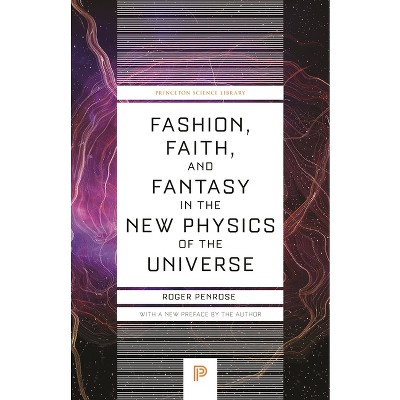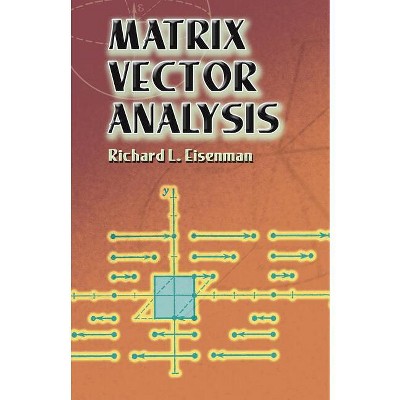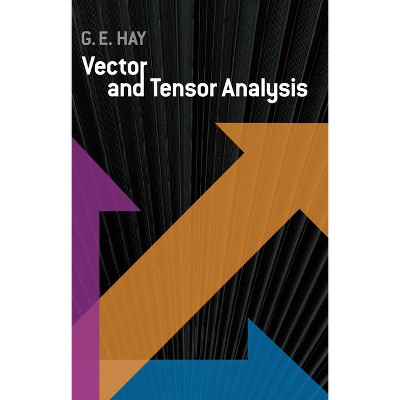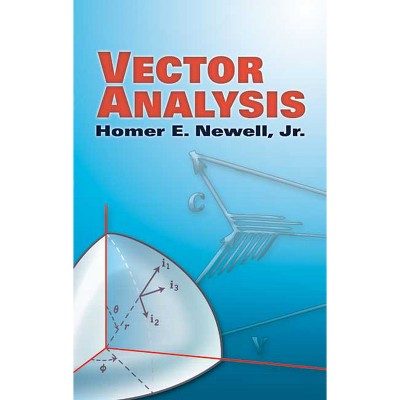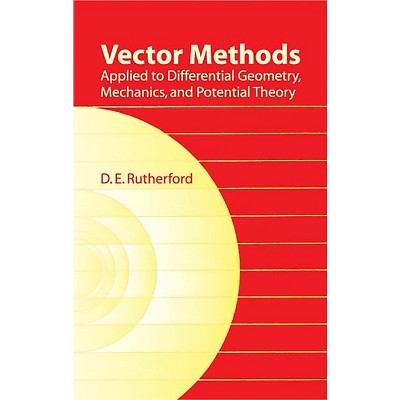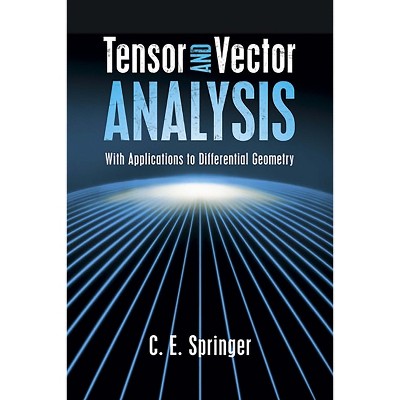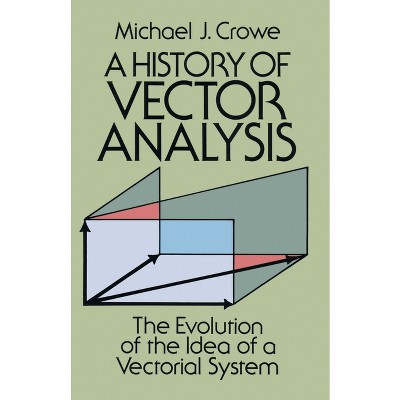Sponsored

Vector - by Robyn Arianrhod (Hardcover)
$25.99Save $2.01 (7% off)
In Stock
Eligible for registries and wish lists
Sponsored
About this item
Highlights
- A celebration of the seemingly simple idea that allowed us to imagine the world in new dimensions--sparking both controversy and discovery.
- Author(s): Robyn Arianrhod
- 376 Pages
- Mathematics, Vector Analysis
Description
About the Book
"The stars of the latest book by award-winning science writer and mathematician Robyn Arianrhod are unlikely celebrities--vectors and tensors. If you took a high school physics course, the word "vector" might remind you of the mathematics needed to determine forces on an amusement park ride, say; or of cross products, a special kind of multiplication using a bespoke table and a right-hand rule. You might also remember the introductory definition of a vector as a quantity that has magnitude and (this is the key) direction. Velocity--for example, 25 miles per hour northwest--is a vector; speed, such as 25 miles per hour, is not. Put another way, a velocity vector in space contains not one number, but three-a measurement of speed along each of three dimensions. It sounds simple, in hindsight--yet, as Arianrhod shows in this intriguing story, the idea of a single symbol expressing several things at once is a sophisticated one, millennia in the making. Vectors are examples of an even more sophisticated idea, the tensor. And it's not just space that vectors and tensors can represent, but information, too. Which means that whenever you use a search engine, say, or AI bot, computer graphics, or a host of other digital applications, vectors and tensors are there somewhere in the software. As for physics, there's much more to it than velocities and simple forces! Arianrhod shows how the discovery of vectors and tensors enabled physicists and mathematicians to think brand new thoughts-such as Maxwell did when he ushered in the wireless electromagnetic age, and Einstein when he predicted the curving of four-dimensional space-time and the existence of gravitational waves. Quantum theory, too, makes fine use of these ideas. In other words, vectors and tensors have been critical not only to the way we see our universe, but also to the invention of Wi-Fi, GPS, micro-technology, and so much else that we take for granted today. In exploring the history and significance of vectors and tensors-and introducing the fascinating people who gave them to us--Arianrhod takes readers on an extraordinary, five-thousand-year journey through the human imagination. A celebration of an idea, Vector shows the genius required to imagine the world in new dimensions-and how a clever mathematical construct can direct the future of discovery"--Book Synopsis
A celebration of the seemingly simple idea that allowed us to imagine the world in new dimensions--sparking both controversy and discovery. The stars of this book, vectors and tensors, are unlikely celebrities. If you ever took a physics course, the word "vector" might remind you of the mathematics needed to determine forces on an amusement park ride, a turbine, or a projectile. You might also remember that a vector is a quantity that has magnitude and (this is the key) direction. In fact, vectors are examples of tensors, which can represent even more data. It sounds simple enough--and yet, as award-winning science writer Robyn Arianrhod shows in this riveting story, the idea of a single symbol expressing more than one thing at once was millennia in the making. And without that idea, we wouldn't have such a deep understanding of our world. Vector and tensor calculus offers an elegant language for expressing the way things behave in space and time, and Arianrhod shows how this enabled physicists and mathematicians to think in a brand-new way. These include James Clerk Maxwell when he ushered in the wireless electromagnetic age; Einstein when he predicted the curving of space-time and the existence of gravitational waves; Paul Dirac, when he created quantum field theory; and Emmy Noether, when she connected mathematical symmetry and the conservation of energy. For it turned out that it's not just physical quantities and dimensions that vectors and tensors can represent, but other dimensions and other kinds of information, too. This is why physicists and mathematicians can speak of four-dimensional space-time and other higher-dimensional "spaces," and why you're likely relying on vectors or tensors whenever you use digital applications such as search engines, GPS, or your mobile phone. In exploring the evolution of vectors and tensors--and introducing the fascinating people who gave them to us--Arianrhod takes readers on an extraordinary, five-thousand-year journey through the human imagination. She shows the genius required to reimagine the world--and how a clever mathematical construct can dramatically change discovery's direction.Review Quotes
Won-- "Choice Magazine: CHOICE Outstanding Academic Title Awards"
Won-- "State Library of New South Wales: General History Prize"
"I recommend this book to all those interested in the historic development of scientific ideas."--Ilhan M. Izmirli "Mathematical Reviews"
"Mathematics began in ancient Mesopotamia five millennia ago. But as mathematician Arianrhod notes, 'it took a very long time to create the idea of a single symbol having both magnitude and direction'--the vector. Conceived in 1843 by William Rowan Hamilton, it subsequently enabled James Clerk Maxwell's theory of electromagnetism, Paul Dirac's quantum field theory, Emmy Noether's connection of mathematical symmetry with energy conservation and more, as this book describes with lively clarity."--Andrew Robinson "Nature"
"A beautiful book to read. It is very carefully researched and well written, and it is bound to make you think. Whether you are interested in popular history of science or would like to know more about the details of how vectors and the laws of physics developed together, I recommend this book."-- "Parabola Journal"
"Arianrhod does a good job of defamiliarising the equivalence of numbers and geometry and guiding the reader through the often controversial history. There are familiar names, such as Newton and Hamilton, and less familiar ones such as Grassman and (Émilie) du Châtelet. Arianrhod talks about how gender, religion and social class excluded some researchers from the formative discussions in elite universities and learned societies. . . . I enjoyed Vector."-- "New Zealand Listener"
"This is a remarkable book . . . but one that's hard to classify. It's part history of science/maths, part popular maths and even has a smidgen of textbook about it, as it has more full-on mathematical content that a typical title for the general public usually has. What Arianrhod does in painstaking detail is to record the development of the concept of vectors, vector calculus and their big cousin tensors. . . . While it's true the early days of calculus have been widely covered, there has been far less on the aspects that Arianrhod gives us, making this a classic find for the right readership. . . . If you fit into the book's target audience, it's a must-have for your shelves."--Brian Clegg "popularscience.co.uk"
"My thanks to Arianrhod for producing perhaps the best historical text about a topic in mathematics. Arianrhod is a great storyteller who gently leads the reader through important yet deep mathematical content via her provision of context--historical and mathematical--while also revealing personal motivations, problems-to-be-solved, disappointments, intellectual disputes, and primacy arguments. Though the book's goal is to tell the story of vectors and tensors, the story is necessarily woven within the histories of algebra, calculus, imaginary numbers, quaternions, matrices, non-Euclidian geometry, differential geometry, physics, electromagnetism, and the Theory of Relativity. In turn, Arianrhod cleverly introduces a wide range of mathematicians, with a focus on their commitment to creativity and human imagination as they helped advance and use the concepts of vectors and tensors. To further help and educate the reader, Arianrhod provides an extensive timeline, extensive notes for each chapter, and a comprehensive index. Readers are encouraged to give the book a try. Let Arianrhod tell her story and expect to be captivated, as it is a demanding book that is difficult to put down before the story is finished . . . though Arianrhod claims the story continues to evolve. Essential."-- "Choice"
"Arianrhod's book is deeply researched. Her 320 pages of text are supplemented with nearly 60 pages of endnotes that provide additional mathematical and historical detail. She also supplies a timeline, which is an invaluable apparatus for a complex narrative such as this. Her account of the history of the 'vector wars' and her capsule biographies of Hamilton, Maxwell, Tait, Grassmann, Ricci-Curbastro, and Levi-Civita are vivid and fascinating. . . . Vector is a valuable contribution to the history of math."-- "SIAM News"
"Arianrhod has an encyclopedic knowledge of the history of physics and mathematics, as well as a deep understanding of often very technical subject matter. . . . Arianrhod's deep research and attention to neglected figures in the history of science, many of them women, is refreshing. . . . Vector is a fascinating read."--Michael Lucy "Australian Book Review"
"Arianrhod tells the story beautifully. . . . [It's] a very human story of how men and women explored and refined pure maths and physics, their friendships and rivalries, frustration and insights. Arianrhod is most effective in describing collaboration across time and nationalities, as well trained minds and curious mavericks picked up the challenge to understand our universe."-- "Daily Telegraph Australia"
"The story is unravelled in roughly chronological order but there is much more, ranging from how the Mesopotamians organised data tables equations, through to the use of quaternions in internet search engines. We learn about the private lives of many of the protagonists and how many of them died relatively young before they had achieved their full potential. There is also a suitable amount of detail, particularly around tensors, so the reader can appreciate not only why a particular piece of mathematics led to an advance, but also how. The book is beautifully organised and is written with wit and impressive scholarship in both history and mathematics. . . . It would make a super prize or gift for a final-year student in school mathematics. . . . Five stars."-- "Physics Education"
"Vector succeeds on several levels, as a stimulating survey of the development of the subject over the centuries, as a reference source for historical work that has been done, and as an accessible exposition of interesting but technical subject matter. In the history of physics and mathematics today the mathematical content is often viewed as something like a black box, with the primary focus being on the professional milieu or biographical and institutional details. It is commendable in a book for a wider audience that so much attention is devoted to looking at the mathematics itself and making it understandable."-- "Annals of Science"
"How these [controversial concepts] laid the foundation of the modern world is part of the story told in a remarkable new book, Vector, by Arianrhod, a historian of science. Understanding her text fully requires an undergraduate-level grasp of maths. But her broader theme is easier to recognise: how social and technological change are intertwined with the progress of mathematical thought."--Randeep Ramesh "Guardian"
"Arianrhod shows, with beautiful ease, that maths is not some foreign world only geeks inhabit. It is the world around us."--Adam Spencer, author of "Adam Spencer's Big Book of Numbers"
"Holiday-making can itself be a lonely business. To while away those sleepless hours on long train journeys, a good book is vital. On the strength of the title alone, what could be more fitting for discombobulated travellers than Arianrhod's Vector. Not only will readers acquire the mathematical ability to determine forces on an amusement park ride (a vital part of parental arsenals), they will also discover how an elegant piece of mathematical notation has changed the way we think about the world."--Simon Ings "New Scientist, "The best science non-fiction books of 2024 so far""
"Terrific. . . . If you take joy in thinking about how the world works, and how a few simple, tiny and beautiful mathematical tools, which express and do so much, evolve from the collective and individual consciousness of humans over time, you'll love Arianrhod's history of vectors, tensors and all the thought and struggle that birthed them. . . . The author's relaxed writing style is superb, her erudition of her field and its history is genuinely impressive, and her understanding of intersectional issues provides nuance and context which all good histories need."-- "Tasmanian Times"
"This remarkable book relates the history of vectors and tensors, including relevant biographical information about the main progenitors of the concepts. The first third of the book is an easy read, with Hamilton's quaternions playing a leading role in the development of vectors (Hamilton invented the term 'vector'). The narrative then turns to the vector formulation of Maxwell's electromagnetic equations and the abandonment of quaternions. The final third requires more of the reader; it considers space-time, introduces tensors, describes their role in general relativity, and discusses Noether's theorems about the association of symmetries with conservation laws."-- "Mathematics Magazine"
"Everyone understands what it means to move at some particular speed in some particular direction. But it took a long time to start thinking of such behavior in terms of a single clarifying concept, the vector. Arianrhod's lively and detailed chronicle explains why vectors and tensors are at the heart of our best ways to think about the universe."--Sean Carroll, author of "The Biggest Ideas in the Universe"
"With a flair for exposition that makes the complex simple, and a gift for storytelling, Arianrhod is without peer in conveying the beauty, and power, of mathematics. William Rowan Hamilton, James Clerk Maxwell, and Albert Einstein come alive in this dramatic tale of a simple idea that changed our world."--Amir Alexander, author of "Infinitesimal: How a Dangerous Mathematical Theory Shaped the Modern World"
"'If all mathematics disappeared, ' physicist Richard Feynman opined, 'it would set physics back precisely one week.' To which mathematician Mark Kac retorted, 'Precisely the week in which God created the world.' Arianrhod persuades us that vectors and tensors are among those creations. Students and teachers should read this excellent book together."--Marjorie Senechal, Smith College, editor-in-chief of "The Mathematical Intelligencer"
"There have been lots of books about the evolution of modern physics: from Newton to Maxwell to Einstein and on to quantum theory. But seldom does an author pay attention to the mathematical revolutions that made those physical theories possible. Only as the mathematical toolkit expanded from simple scalars to include such tools and ideas as quaternions and vectors and tensors could physicists and mathematicians find the language to describe an increasingly bewildering universe. Arianrhod does a remarkable job telling the story of the mathematical revolution under the hood, the engine that drove the physics revolutions of the nineteenth and twentieth centuries; the result is a book well worth your time."--Charles Seife, author of "Zero: The Biography of a Dangerous Idea"
"A vector is quantity that has magnitude and, crucially, direction. This idea has enabled physicists and mathematicians to imagine and describe the world in new dimensions. The author traces the influence of vectors over the past 5,000 years, and why vectors (and tensors) are still relevant today."-- "The Bookseller"
"Arianrhod's Vector, a masterpiece of science exposition, reads as a welcoming cognitive cliffhanger tour of vectors, their generalizations, and their accompanying symbolic tools of mathematical physics, all dovetailing through germane history vignette accounts of astonishing connections and applications."--Joseph Mazur, author of "The Clock Mirage: Our Myth of Measured Time"
Dimensions (Overall): 8.58 Inches (H) x 5.67 Inches (W) x 1.42 Inches (D)
Weight: 1.4 Pounds
Suggested Age: 22 Years and Up
Number of Pages: 376
Genre: Mathematics
Sub-Genre: Vector Analysis
Publisher: University of Chicago Press
Format: Hardcover
Author: Robyn Arianrhod
Language: English
Street Date: May 29, 2024
TCIN: 1006100669
UPC: 9780226821108
Item Number (DPCI): 247-50-0656
Origin: Made in the USA or Imported
If the item details aren’t accurate or complete, we want to know about it.
Shipping details
Estimated ship dimensions: 1.42 inches length x 5.67 inches width x 8.58 inches height
Estimated ship weight: 1.4 pounds
We regret that this item cannot be shipped to PO Boxes.
This item cannot be shipped to the following locations: American Samoa (see also separate entry under AS), Guam (see also separate entry under GU), Northern Mariana Islands, Puerto Rico (see also separate entry under PR), United States Minor Outlying Islands, Virgin Islands, U.S., APO/FPO
Return details
This item can be returned to any Target store or Target.com.
This item must be returned within 90 days of the date it was purchased in store, shipped, delivered by a Shipt shopper, or made ready for pickup.
See the return policy for complete information.






